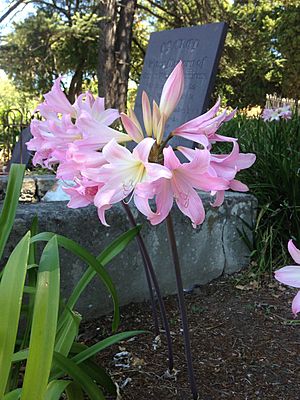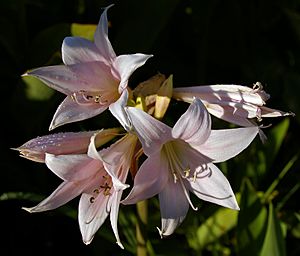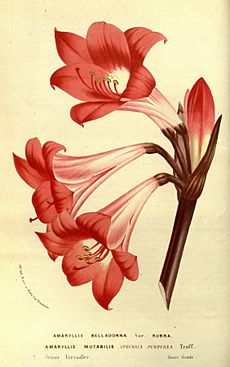Amaryllis facts for kids
Quick facts for kids Amaryllis |
|
|---|---|
 |
|
| Amaryllis belladonna | |
| Scientific classification |
|
| Kingdom: | Plantae |
| Clade: | Tracheophytes |
| Clade: | Angiosperms |
| Clade: | Monocots |
| Order: | Asparagales |
| Family: | Amaryllidaceae |
| Subfamily: | Amaryllidoideae |
| Tribe: | Amaryllideae |
| Genus: | Amaryllis L. |
| Type species | |
| Amaryllis belladonna L.
|
|
| Species | |
The Amaryllis is a special type of flowering plant that grows from a bulb. It is the only plant in its group, called a genus. There are only two known kinds, or species, of Amaryllis.
The most famous one is Amaryllis belladonna. This plant originally comes from the Western Cape area of South Africa. It likes rocky places, especially between the Olifants River Valley and Knysna.
For a long time, scientists were confused about the names Amaryllis and Hippeastrum. Because of this, the name "amaryllis" is often used for plants from the Hippeastrum genus. These are the popular indoor plants sold in winter that bloom inside your home.
Plants from the true Amaryllis genus have many common names. People call them belladonna lily, Jersey lily, naked lady, amarillo, or Easter lily in Southern Australia. In South Africa, they are known as March lily because they often bloom around March. Even though they are called "lily" because of their flower shape, they are not closely related to the real lily, Lilium. In the old Victorian Language of Flowers, the amaryllis flower means "pride, determination, and radiant beauty."
Contents
What does Amaryllis look like?
The Amaryllis plant grows from a round bulb, which is like a large onion. Each bulb is about 5 to 10 centimeters (2 to 4 inches) wide.
It has several long, green leaves that look like straps. These leaves are about 30 to 50 centimeters (12 to 20 inches) long and 2 to 3 centimeters (about 1 inch) wide. They grow in two rows. The leaves usually appear after the flowers have bloomed.
Each bulb grows one or two strong, straight stems that have no leaves. These stems can be 30 to 60 centimeters (1 to 2 feet) tall. At the top of each stem, you'll find a cluster of 2 to 12 beautiful, funnel-shaped flowers.
Each flower is about 6 to 10 centimeters (2 to 4 inches) wide. They have six petals that spread out. The flowers are usually white with red veins, but you can also find pink or purple ones.
How Amaryllis is Named and Grouped
The Amaryllis plant belongs to a group called Amaryllidinae. This group is part of a larger family of plants called Amaryllideae.
For many years, there was a big discussion among plant scientists about the name Amaryllis. In 1753, a famous scientist named Carl Linnaeus first named the plant Amaryllis belladonna. At that time, plants from both South Africa and South America were put into the same group. Later, scientists realized they were different and separated them.
The main question was: which plant did Linnaeus mean when he first used the name Amaryllis? Was it the South African plant or the South American one? If it was the South American one, then Amaryllis would be the correct name for the Hippeastrum plants, and the South African plant would need a new name.
After a long debate, in 1987, a big meeting of botanists decided. They agreed that Amaryllis should be the official name for the South African plant, Amaryllis belladonna. This helped clear up the confusion.
Types of Amaryllis Species
As of October 2020, there are only two accepted species of Amaryllis. Both of them grow naturally in the Cape Provinces of South Africa:
- Amaryllis belladonna – This species is found in the southwest Cape Provinces. It has also been introduced and now grows wild in many other parts of the world, like California, Great Britain, Australia, and New Zealand.
- Amaryllis paradisicola – This species is found in the west Cape Provinces.
What the Name Amaryllis Means
The name Amaryllis comes from an old story. It's named after a shepherdess in a poem by a writer named Virgil. The Greek word "amarysso" means "to sparkle." The name might also come from "amarella," which means "bitterness," referring to the taste of the bulb.
Even though scientists decided on the official name for the genus, people still use "amaryllis" for different plants. For example, the bulbs sold as "amaryllis" that bloom for holidays are actually from the Hippeastrum group.
The common name "naked lady" for Amaryllis comes from how it flowers. The plant's leaves die down first, and then the flowers appear on a bare stem. Other bulbs that flower this way also share this name.
Where Amaryllis Lives
In its natural home, especially in mountainous areas with a type of plant life called fynbos, the Amaryllis might not flower much. This happens when there are many other plants growing thickly overhead, blocking the light. But after a bush fire, when the overhead plants are gone, the Amaryllis tends to flower more.
In more open, sandy areas of the Western Cape, the plant flowers every year. Amaryllis plants often grow in dense groups in one spot. This is because their seeds are large and heavy. When strong winds shake the seeds loose, they fall to the ground nearby. They start to grow right away, especially with the first winter rains.
Amaryllis Life Cycle
The leaves of the Amaryllis plant grow in the autumn or early spring, depending on when the rains start. They usually die back by late spring. Then, the bulb rests underground until late summer.
This plant does not like frost, so it won't grow well in very cold places. It also doesn't do well in tropical areas because it needs a dry resting period. This dry time is important between when its leaves grow and when its flower stems appear.
In late summer, one or two leafless stems grow from the bulb in the dry ground. This happens around March in its native South Africa, or August in places like USDA zone 7.
The Amaryllis has a special partnership, called a symbiotic relationship, with carpenter bees. This means they help each other. The plant is also visited by noctuid moths at night. Scientists are still studying how important these insects are for pollination. However, carpenter bees are thought to be the main pollinators for Amaryllis on the Cape Peninsula. The main pests that attack the plant are the lily borer insects, Brithys crini or Diaphone eumela.
Growing Amaryllis
Amaryllis belladonna started being grown by people in the early 1700s. It grows slowly, either by dividing its bulbs or by seeds. Over time, it has started growing wild in many urban and suburban areas along the West Coast of the USA. This is because these places have a climate similar to its home in South Africa. It can grow in hardiness zones 6 to 8. It has also become naturalized in Australia.
There is a special Amaryllis belladonna hybrid that was created in Australia in the 1800s. A hybrid is a plant made by crossing two different types. No one knows exactly which other species it was crossed with. This hybrid created new flower colors like white, cream, peach, magenta, and even almost red.
These hybrids were then crossed back with the original Amaryllis belladonna and with each other. This created new plants that produce seeds naturally. These new plants have a huge variety of flower sizes, shapes, stem heights, and shades of pink. Pure white types with bright green stems were also developed.
The hybrid flowers are quite different. Their many shades of pink can also have stripes, veins, darker edges, or light centers. This sets them apart from the original light pink flowers. Also, the hybrids often have flowers that form a fuller circle, instead of just facing one side like the older types. These hybrids can adapt to being watered and fertilized all year. But they can also survive completely dry summer conditions if they need to.
Amaryllis belladonna has won an important award called the Royal Horticultural Society's Award of Garden Merit. This award means it's an excellent plant for gardens.
Scientists have also crossed Amaryllis belladonna with another plant called Crinum moorei. This created a new hybrid plant called × Amarcrinum. There are also hybrids said to be between Amaryllis belladonna and Brunsvigia josephinae, which have been called × Amarygia. However, these hybrid names are not officially accepted by all plant lists.
See also
 In Spanish: Amaryllis para niños
In Spanish: Amaryllis para niños



